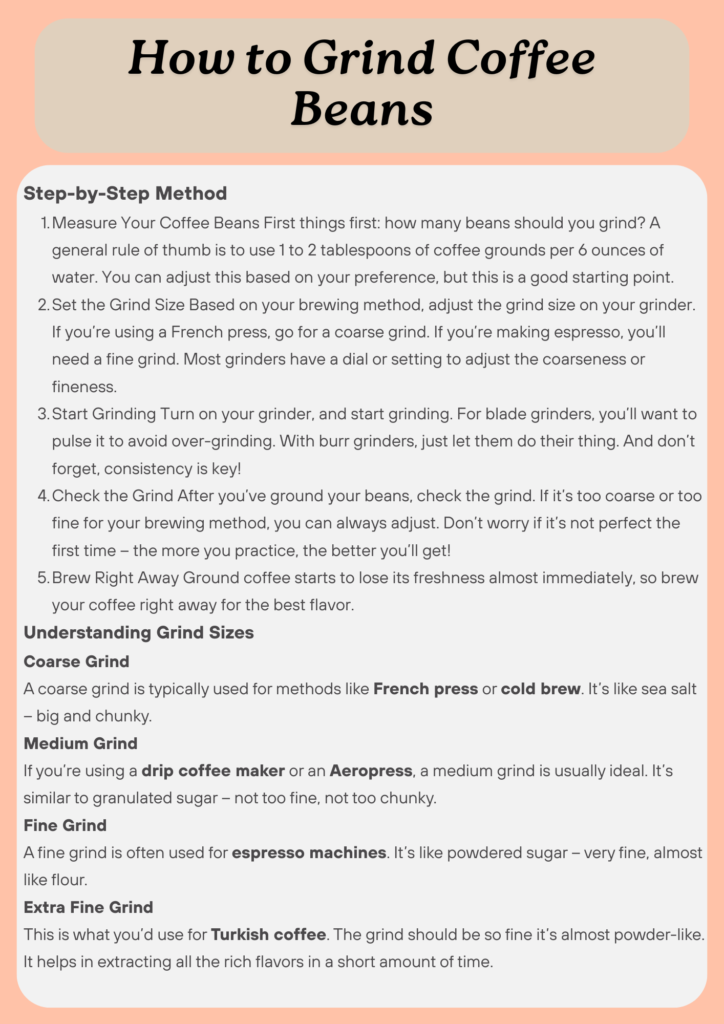Are you one of those people who just can’t start their day without a cup of coffee? If so, you’re in the right place! Grinding your own coffee beans might seem like a lot of work, but trust me, the fresh aroma of ground beans in your kitchen makes it totally worth it. It’s like having a coffee shop right in your own home. Whether you’re new to the world of coffee or just looking to elevate your caffeine game, knowing how to grind coffee beans is the first step to making that perfect cup.
So, let’s dive in! I’ll walk you through everything from choosing the right grinder to understanding grind sizes, and why all of it matters in making your morning coffee just right. Plus, you’ll learn some common mistakes people make when grinding their coffee beans. Let’s get started!
1. Why Grind Your Own Coffee Beans?
Before we get into the how, let’s talk about the why. Freshly ground coffee beans make a world of difference in the flavor and aroma of your coffee. Pre-ground coffee might be convenient, but it quickly loses its freshness and those rich oils that give your coffee its full-bodied flavor. Grinding your own beans ensures that you’re capturing that peak freshness in every cup. Plus, you get to control the grind size, which is crucial for making the perfect brew.
And don’t worry if you’ve been using pre-ground coffee for years – it’s never too late to start grinding your beans fresh. Trust me, you’ll notice the difference!
2. Choosing the Right Coffee Grinder
Okay, now let’s talk about the grinders. There are two main types of coffee grinders: blade grinders and burr grinders. They each have their pros and cons, so let’s break it down.
Blade Grinders
Blade grinders are usually the more affordable option, and they work by chopping the beans with a spinning blade. The problem here, though, is that they often produce an inconsistent grind. Some bits might be really fine, while others are chunkier. This inconsistency can lead to uneven extraction during brewing, making your coffee taste a bit off. But hey, they’re great for beginners on a budget.
Burr Grinders
Burr grinders, on the other hand, are the go-to for serious coffee lovers. They use two revolving abrasive surfaces to crush the beans evenly, giving you a much more consistent grind. There are two types of burr grinders: flat burrs and conical burrs, but let’s not get too technical just yet. The main thing is, burr grinders give you a much more uniform grind, which helps you extract all the great flavors from the beans during brewing. They tend to be pricier, but they’re totally worth the investment.
So, if you’re serious about your coffee, burr grinders are definitely the way to go. If you’re just getting started, a blade grinder is fine, but be prepared to possibly upgrade later.
3. Understanding Grind Sizes
Now that you’ve picked your grinder, let’s talk about grind size. This is super important because it directly affects the flavor of your coffee. Different brewing methods require different grind sizes to get the best extraction.
Coarse Grind
A coarse grind is typically used for methods like French press or cold brew. It’s like sea salt – big and chunky. This grind allows the coffee to steep for a longer time without over-extracting and becoming bitter.
Medium Grind
If you’re using a drip coffee maker or an Aeropress, a medium grind is usually ideal. It’s similar to granulated sugar – not too fine, not too chunky. This grind gives the coffee enough surface area to extract flavor at a moderate speed.
Fine Grind
A fine grind is often used for espresso machines. It’s like powdered sugar – very fine, almost like flour. Because espresso involves forcing water through the coffee under pressure, a finer grind helps create the right resistance to get that rich, bold shot.
Extra Fine Grind
This is what you’d use for Turkish coffee. The grind should be so fine it’s almost powder-like. It helps in extracting all the rich flavors in a short amount of time.
4. How to Grind Coffee Beans: Step-by-Step
Alright, let’s get to the good stuff. Here’s how you can grind your coffee beans for the perfect brew.
- Measure Your Coffee Beans First things first: how many beans should you grind? A general rule of thumb is to use 1 to 2 tablespoons of coffee grounds per 6 ounces of water. You can adjust this based on your preference, but this is a good starting point.
- Set the Grind Size Based on your brewing method, adjust the grind size on your grinder. If you’re using a French press, go for a coarse grind. If you’re making espresso, you’ll need a fine grind. Most grinders have a dial or setting to adjust the coarseness or fineness.
- Start Grinding Turn on your grinder, and start grinding. For blade grinders, you’ll want to pulse it to avoid over-grinding. With burr grinders, just let them do their thing. And don’t forget, consistency is key!
- Check the Grind After you’ve ground your beans, check the grind. If it’s too coarse or too fine for your brewing method, you can always adjust. Don’t worry if it’s not perfect the first time – the more you practice, the better you’ll get!
- Brew Right Away Ground coffee starts to lose its freshness almost immediately, so brew your coffee right away for the best flavor.
5. Common Mistakes to Avoid When Grinding Coffee Beans
Even seasoned coffee lovers make mistakes, so don’t feel bad if you mess up once or twice. Here are some common mistakes you should try to avoid:
1. Grinding Too Much Coffee
It’s tempting to grind a whole bunch of coffee and store it for later, but that’s a mistake. Ground coffee loses freshness quickly. Only grind what you need for your cup, so you get the freshest flavor.
2. Not Adjusting the Grind Size
If you don’t adjust the grind size for your brewing method, your coffee might taste weak or bitter. A French press needs a coarse grind, while an espresso machine requires a fine grind. Make sure to adjust accordingly!
3. Using an Inconsistent Grind
Inconsistent grind size can lead to uneven extraction, making your coffee taste off. A burr grinder will help you avoid this problem, but if you’re using a blade grinder, try pulsing it to get a more even grind.
4. Not Cleaning Your Grinder
Coffee grinders can accumulate old coffee oils and grounds, which can impact the flavor of your fresh beans. Clean your grinder regularly to keep things tasting fresh.

Conclusion: Enjoy Your Perfect Cup of Coffee!
Grinding coffee beans might seem like a small step, but it’s the foundation of making great coffee. Whether you’re using a blade grinder or a high-end burr grinder, understanding grind sizes and brewing methods will make a huge difference in your cup. The best part? You get to experiment, adjust, and find your perfect grind size over time. So grab those beans, fire up your grinder, and brew yourself the best cup of coffee you’ve ever had!
